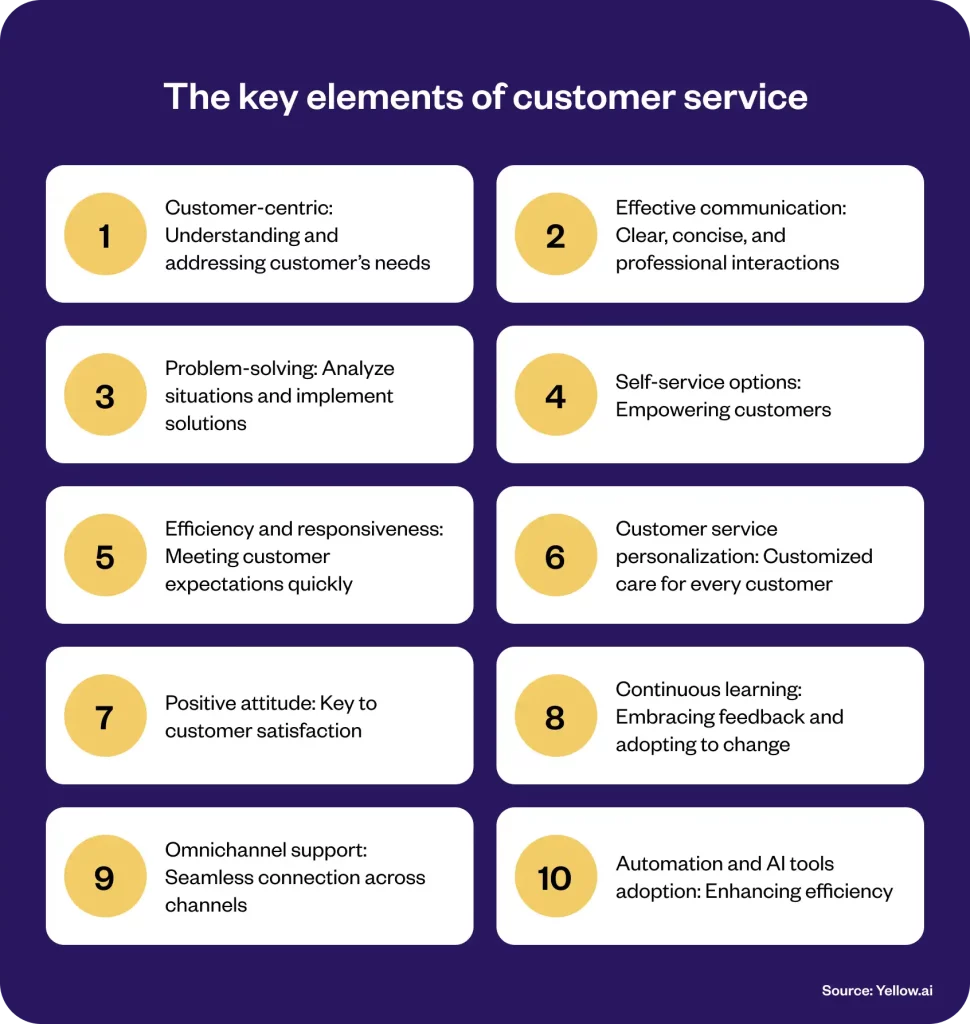Elements of customer service represent the crucial building blocks that shape an unparalleled customer experience. Yet, one might ponder what constitutes these elements and why they assume such critical significance in today’s market dynamics.
These elements of good customer service extend beyond crafting a remarkable customer journey; they are pivotal in enhancing your organization’s profitability and revenue streams. A study by Zippia reveals a compelling narrative: enterprises prioritizing customer experience (CX) boast a 60% increase in profitability and witness an 80% surge in revenue. This compelling data highlights the indispensable role of customer service elements in securing a competitive edge.
Throughout this blog, we delve into what are the key elements of customer service, offering a comprehensive exploration of each component. Our objective is to give enterprise leaders the insights needed to refine their customer service strategies, ensuring they remain at the forefront of customer satisfaction and business success.
Related must-reads:
- Customer service automation – A full guide
- AI in customer service – Benefits and examples
- 10 Types of customer service you should know
- Top 10 customer service tips for 2024: Elevate your support
What is customer service?
Assisting customers throughout their entire journey, from before, during and after a purchase, is what customer service is all about. It goes beyond simply resolving issues or responding to inquiries, it involves creating a pleasant and unforgettable experience that fosters loyalty and sets your brand apart from competitors in a saturated market.
In today’s digital age, exceptional customer service is pivotal for business growth, influencing loyalty, brand reputation, and the bottom line. Companies that excel in delivering outstanding customer service not only attract but also retain customers, fostering a cycle of success that is reflected in increased profitability and revenue.
Related must-reads:
- Retail customer service – tips & examples
- Ecommerce customer service – A guide for 2024
- 10 Ways to improve customer service in banking
- How to improve customer service in the BPO industry?
What is good customer service?
Good customer service is a crucial element of a thriving business, defined by providing timely, compassionate, and efficient assistance that satisfies and surpasses customer desires. It goes beyond resolving problems to establish a memorable and valuable customer encounter.
The following are the qualities that distinguish good customer service:
- Promptness: Quick responses and efficient problem-solving signal respect for the customer’s time.
- Personalization: Tailoring service to meet individual customer needs shows care and attention to detail.
- Professionalism: Maintaining high professionalism even in challenging situations, builds trust and credibility.
- Follow-up: Checking in with customers post-resolution to ensure their satisfaction underscores a commitment to their overall experience.
- Empathy: Understanding and empathizing with the customer’s situation fosters a genuine connection and can turn a negative experience into a positive one.
In essence, good customer service transcends traditional support; it’s about building lasting relationships that contribute to sustained business growth and a strong brand reputation.
10 Key elements of customer service
Identifying and understanding its fundamental elements is crucial to excel in customer service. This section will highlight the top 10 key elements of customer service, each representing a cornerstone in the architecture of exceptional customer experiences. These components are practices and principles that shape how businesses connect with and serve their customers, ensuring satisfaction and loyalty.

1. Customer-centric: Understanding and addressing customer’s needs
Embracing a customer-centric approach in customer service means diving deep into understanding your customers’ needs, preferences, and past interactions. This profound insight enables support teams to deliver solutions and personalized experiences that resonate more deeply. McKinsey & Company’s findings highlight the power of this approach, with personalized communication boosting repurchase likelihood for 78% of customers, showcasing the undeniable impact of truly knowing your customer.
A customer-centric strategy is about more than just solving problems but doing so with creativity and dedication, even when solutions are not straightforward. This involves exploring alternative solutions, providing workarounds, and, when necessary, channeling feedback to management for systemic improvements. Such commitment to each customer’s success fosters a sense of partnership and trust, leading to service interactions that are not only effective but memorable, setting a new standard for excellence in customer service.
2. Effective communication: Clear, concise, and professional interactions
Effective communication is a pillar of customer service, emphasizing the importance of connecting with customers on a human level. Customer service representatives can significantly enhance customer satisfaction by understanding their needs and articulating solutions clearly and empathetically. The art of effective communication is not just in speaking but in active listening—attentively hearing and understanding the customer’s words and emotions. This approach allows for a deeper comprehension of the issues at hand, enabling the delivery of targeted solutions that truly address the customer’s concerns.
To achieve this, employing clear, concise language free from jargon is essential, ensuring that explanations are easily understood and actionable. Moreover, empathetic communication, using phrases conveying understanding and compassion, is crucial in making customers feel valued and heard. Representatives can foster a more open and trusting dialogue through empathetic phrases and open-ended questions, laying the groundwork for positive and productive interactions.
3. Problem-solving: Analyze situations and implement solutions
Problem-solving in customer service is more than just addressing issues as they arise; it’s about analyzing situations thoroughly, understanding the underlying problems, and identifying efficient solutions. This process requires a blend of analytical thinking and creativity, as customer service representatives must often navigate complex issues that don’t have straightforward answers. By breaking down problems into manageable parts and considering various outcomes, representatives can develop strategies that effectively resolve customer concerns, leading to higher satisfaction.
Efficient problem-solving also involves acting swiftly and decisively. Once a solution is identified, implementing it quickly is critical to maintaining customer trust and demonstrating your company’s commitment to their satisfaction. This agility in problem-solving resolves individual issues more effectively. It contributes to a culture of excellence within customer service teams, ensuring that every customer interaction is an opportunity to reinforce positive perceptions of your brand.
Pelago reimagines customer experience with generative AI-powered conversational AI agents

4. Self-service options: Empowering customers
The inclusion of robust self-service enables customers to find answers and solutions independently. By curating comprehensive FAQs and knowledge base articles, businesses facilitate a smoother customer experience and empower their clientele. This empowerment is crucial in today’s fast-paced world, where customers prefer quick, direct solutions. McKinsey’s “The State of Customer Care in 2022” highlights that 65% of customer care leaders see improved self-service as a key driver in reducing call volumes, illustrating the significant impact of self-service capabilities on operational efficiency.
Moreover, the strategic implementation of self-service tools can lead to a notable decrease in the number of support tickets, allowing customer service representatives to allocate more time to address complex issues that require deeper insight and personalized attention. This shift enhances the quality of support for more intricate inquiries and improves overall customer satisfaction by streamlining access to information.
5. Efficiency and responsiveness: Meeting customer expectations quickly
Efficiency and responsiveness are not just operational goals but critical to customer satisfaction. With 90% of customers valuing immediate responses to their inquiries, the pressure is on businesses to meet these expectations. This urgency underscores the modern customer’s demand for quick solutions, challenging companies to adapt their service models to accommodate this on-demand mentality.
Leveraging technology like automated customer service systems and chatbots can be a strategic move, offering instant answers to straightforward questions and significantly improving response times. Moreover, quick response times exceed expectations; they convey to customers that they are heard and that their issues are a priority. An efficient resolution process further enhances this perception, demonstrating a commitment to addressing and solving customer problems.
6. Customer service personalization: Customized care for every customer
Personalization in customer service is not just a preference; it’s becoming a mandate. According to Salesforce, 73% of customers anticipate enhanced personalization as technology progresses, signaling a clear demand for services tailored to individual needs and preferences. Personalization strengthens relationships and significantly improves the customer experience, encouraging loyalty and advocacy. It catalyzes retaining customers and opportunities like cross-selling, upselling, and increasing consumer spending.
To meet and exceed these expectations, support agents are encouraged to use customer data effectively, address individuals by name, acknowledge previous interactions, and craft responses that address current inquiries. Personalized recommendations based on a customer’s past behavior and preferences can enhance the relevance of your offerings. This strategic approach to personalization, underscored by the growing expectation for customized care, highlights the importance of evolving service strategies in tandem with technological advancements.
7. Positive attitude: Key to customer satisfaction
A service representative’s positive demeanor significantly impacts the customer’s perception, turning potential challenges into meaningful engagement and resolution opportunities. This attitude is crucial, as it directly influences customer satisfaction and loyalty, creating a welcoming atmosphere that encourages open communication. By approaching interactions with optimism and empathy, representatives can diffuse tension and foster a more positive experience, even in difficult situations, ensuring customers feel supported throughout their journey.
Implementing this positive approach across customer service operations involves training and encouraging teams to maintain a helpful, empathetic stance in every interaction. Doing so improves the immediate service experience and builds a reputation for your brand as genuinely customer-focused, elevating your standing in a competitive market. A consistently positive attitude becomes a powerful tool in retaining customers and enhancing overall service quality, making it a non-negotiable element of customer service strategies.
8. Continuous learning: Embracing feedback and adopting to change
In the ever-evolving customer service landscape, continuous learning is vital. Leveraging customer feedback is essential for businesses aiming for long-term success, offering invaluable insights into customer perceptions and experiences. Such feedback highlights areas for product enhancement and customer experience gaps and gauges overall satisfaction, informing strategic decisions and fostering product and service improvements.
However, collecting feedback is merely the beginning. Analyzing this information critically is key to transforming general comments into actionable insights. Whether positive feedback or constructive criticism, every piece of customer input is a chance to learn and improve. Maintaining professionalism and viewing challenges as growth opportunities are fundamental in evolving service offerings and aligning them with customer expectations. Through systematic feedback collection, analysis, and response, businesses can adapt to changing trends and continuously refine their approach to customer service, ensuring they remain responsive and relevant in a dynamic market.
9. Omnichannel support: Seamless connection across channels
Omnichannel support is essential in modern customer service, ensuring a consistent experience across all interaction points. Customers expect to switch between text, phone, chat, or other mediums without repeating their issues, enhancing their service experience. Businesses can significantly reduce frustration and improve satisfaction by offering flexibility in communication based on customers’ preferences and situations.
Related read: Seamless omnichannel CX: Your step-by-step guide
Effective omnichannel support requires a unified view of each customer’s history and preferences. This approach allows service representatives to provide personalized assistance with the full context at every touchpoint, facilitating quicker resolution of issues. Connecting various support channels eliminates the need for customers to restart the service process when switching mediums, setting a new standard for customer support in the digital age.
Unify your CX with omnichannel AI automation

10. Automation and AI tools adoption: Enhancing efficiency
Integrating automation and customer service AI solutions is a strategic imperative, not just an element of customer service. An Intercom report highlights that 81% of customer support leaders believe technology adoption, including AI and automated tools, positively impacts team engagement and reduces attrition. AI-powered chatbots and help desks are prime examples, significantly boosting efficiency and enabling teams to manage their workloads more effectively.
Moreover, the Zendesk Customer Experience Trends Report 2024 underscores the growing importance of customer experience, with 81% of business leaders identifying it as a key priority. This consensus reflects the recognition of customer service as a necessity and a vital differentiator in the competitive market. Utilizing AI and automation streamlines operations and personalizes customer interactions, setting the stage for superior service delivery and customer satisfaction.
Elements of bad customer service
Having explored the key elements of good customer service, it’s equally crucial to recognize the flip side. Understanding the elements of bad customer service provides valuable insights into what to avoid, ensuring your service strategies meet and exceed customer expectations. This awareness can help prevent the pitfalls that lead to dissatisfaction and disengagement, safeguarding your brand’s reputation and customer loyalty.

Here are some elements of bad customer service:
1. Lack of empathy
A lack of empathy in customer service interactions can severely damage the relationship between a business and its customers. Understanding and relating to a customer’s feelings and needs are crucial for fostering a positive experience. Service can feel cold and impersonal without empathy, leading to dissatisfaction and a diminished likelihood of customer retention.
2. Inefficiency and long wait times
Slow response times and extended waits are among the most critical flaws in customer service, instantly dampening the customer experience in an era where speed and convenience are paramount. Investing in real-time support solutions like automation and AI is essential for businesses aiming to remain competitive and responsive to customer needs.
3. Lack of product or service knowledge
Insufficient knowledge of the product or service offered undermines customer service teams’ credibility. Representatives need to have a thorough understanding of what they’re supporting to provide accurate and helpful information. A knowledge gap can lead to misinformation and erode customer trust.
4. Unresponsiveness to complaints
Ignoring or delaying responses to customer complaints can significantly harm a brand’s reputation and customer relationships. Prompt and attentive handling of issues reflects a company’s commitment to customer satisfaction. Unresponsiveness frustrates customers and signals a lack of concern for their experience.
How does Yellow.ai help with automating customer support?
After delving into the elements of both effective and poor customer service, it’s clear that the path to excellence lies in innovation and adaptability. Enter Yellow.ai, a platform at the vanguard of customer support transformation. Its next-gen AI-powered suite is designed to elevate customer interactions by optimizing support processes and enhancing the customer experience. Yellow.ai’s solutions signify a leap towards setting new industry standards, bridging the gap between traditional service methods and the future of customer engagement.
Let’s delve into how Yellow.ai contributes to automating and optimizing customer support:
Unifying channels
Yellow.ai’s omnichannel capabilities ensure a seamless customer experience across all platforms, enabling information access in a unified manner. This integration allows customers to transition between communication channels without repeating their issues, ensuring continuity and coherence in every interaction. Yellow.ai facilitates smoother and more efficient customer service by bridging the gap between different platforms.
Personalizing interactions
Yellow.ai excels in delivering highly personalized customer service by recognizing and adapting to individual patterns and preferences. This capability allows the platform to tailor recommendations and solutions specifically to each customer’s needs, elevating the customer experience to new heights. Through its advanced AI, Yellow.ai ensures that every interaction fosters a deeper connection and understanding between the business and its customers.
Empowering self-service
Yellow.ai’s chatbots epitomize the power of self-service by providing immediate, efficient access to information drawn from vast databases. This capability ensures that customers can quickly find answers to their questions without human intervention, streamlining the support process and significantly enhancing user satisfaction. By enabling customers to help themselves through an intuitive platform, Yellow.ai optimizes the customer experience and alleviates the workload on support teams.
Enhancing responsiveness
Yellow.ai’s customer service suite excels in efficiency and responsiveness, providing round-the-clock availability to address customer inquiries instantly. This 24/7 support capability ensures that customers receive prompt attention and resolutions no matter the time or issue, significantly improving the speed and quality of service. By leveraging Yellow.ai, businesses can offer unparalleled responsiveness, ensuring customer satisfaction and loyalty through swift and effective problem-solving.
Analyzing sentiments
Yellow.ai’s AI solutions have advanced sentiment analysis capabilities, enabling them to discern the customer’s mood during interactions. This intuitive understanding allows the platform to respond with empathy, adding a human touch to conversations that can significantly enhance the customer experience. By adjusting responses to align with the customer’s emotional state, Yellow.ai fosters more meaningful and supportive dialogues.
Gathering insights
Yellow.ai goes beyond traditional customer support by collecting data and analyzing chat interactions to identify trends and insights. This robust analysis helps businesses understand customer preferences, pain points, and service expectations more deeply. With this knowledge, companies can refine their customer service strategies, ensuring they are always aligned with customer needs and industry standards. Yellow.ai’s commitment to leveraging feedback for continuous improvement underscores its role as a vital tool in shaping and enhancing customer service practices.
Conclusion
In navigating the intricacies of customer service, it becomes evident that the elements of customer service are foundational and transformative, shaping an unparalleled customer experience that drives business success. As we’ve explored, these elements—from empathy and efficiency to personalization and responsiveness—underscore the profound impact of customer service on an organization’s reputation and financial health.
Integrating innovative solutions like those offered by Yellow.ai marks a pivotal shift towards automating and optimizing customer support, ensuring that businesses not only meet but exceed their customers’ evolving expectations. By embracing the future of customer engagement with Yellow.ai, companies can leverage AI’s power to deliver effective and memorable service, setting a new standard in customer service.
Elevate your customer service team with Yellow.ai





















